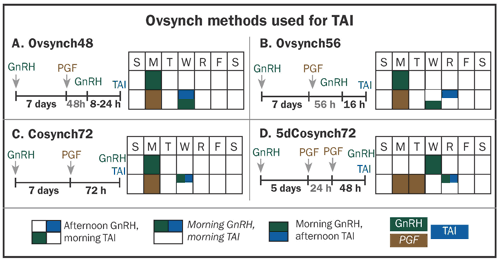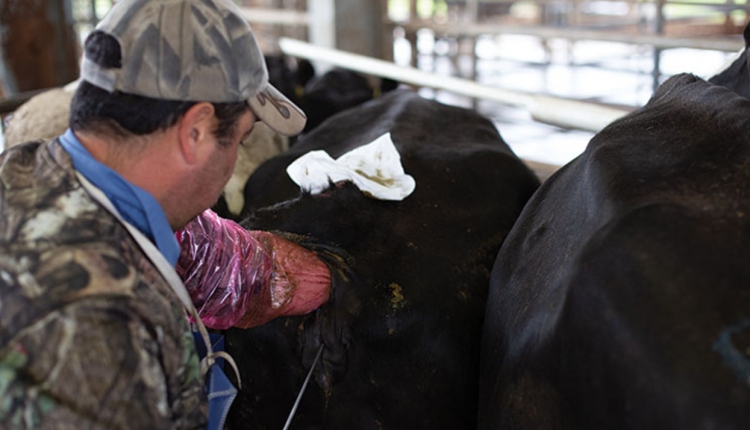The author is professor of animal sciences at Kansas State University, Manhattan.
The August 10 Artificial Breeding column on page 490 highlighted a new reproduction protocol sheet created by the Dairy Cattle Reproduction Council. It is available on their website, www.dcrcouncil.org, listed under Educational Resources. This new sheet is based on years of meticulous research to produce effective and successful programs that can help us get cows bred. Let's discuss each of the important components that produce a successful program.
Basic timed A.I.
Shown in the figure are four alternatives of the Ovsynch protocol forming the basis of most timed A.I. programs since the late 1990s. Each shares several common components:
1. Up-front injection of GnRH (GnRH-1; 2 cc of either Cystorelin, Factrel, Fertagyl, or OvaCyst)
2. One or two injections of prostaglandin (PGF; 2 cc of Estrumate or estroPLAN; or 5 cc of Lutalyse or Prostamate)
3. Breeding injection of GnRH (GnRH-2)
4. Timed A.I.
Up-front GnRH
The purpose of the up-front injection of GnRH is to synchronize a new follicular wave. This occurs when GnRH causes the cow's pituitary gland to release the ovulatory hormone, LH, in sufficient amounts, to cause ovulation. As a result, a new group (wave) of follicles emerges from the ovaries from which a new dominant follicle is selected. The new dominant follicle will become the preovulatory follicle that produces the egg for fertilization after timed A.I.
Almost 70 percent of our cows have estrous cycles with two waves of follicle development. Follicular synchronization does not occur in all cows because treatment with GnRH-1 at random stages of the estrous cycle induces ovulation in only 55 to 65 percent of the cows. When ovulation after GnRH-1 occurs, these cows will have at least one, but often more than one, luteal structure or corpus luteum (CL), including any luteal structure(s) present before GnRH-1 was administered.
Prostaglandin
In the remaining cows that did not ovulate, if they have a luteal structure, and in those cows that responded to GnRH-1, PGF is administered to cause the luteal structure(s) to regress and allow for final follicular maturation. If nothing more is done, a large percentage should express estrus in 2 to 5 days after PGF. Generally, only one injection of PGF is necessary to bring the cow into proestrus and later into estrus or heat.
When one uses Option D (5-day Cosynch 72), a second PGF injection is necessary to lyse or breakdown any new luteal structure that formed in response to the GnRH-1 injection. In the 7-day standard options A, B, or C, shown in the figure, there is sufficient time for new luteal structures to mature and become responsive to PGF. In the 5-day option, however, those new luteal structures will not regress after a single PGF injection, so a second PGF injection is required 24 hours after the first PGF.
Breeding GnRH
The purpose of the GnRH-2 injection is to cause the preovulatory follicle to ovulate after GnRH-2. Timing of GnRH-2, 48 to 72 hours after PGF (or after the first PGF in the 5-day program), is important. If that injection is given too early, the preovulatory follicle is still immature whereas, if given too late, a spontaneous LH release will occur and interfere with the planned coordinated timing of ovulation and semen placement before A.I.
We want the semen placed in the body of the uterus about 10 to 14 hours before ovulation. That time period allows for sperm transport to the junction of the uterine horn and its corresponding oviduct and sperm maturation (capacitation and acrosome reaction) before fertilization. Ovulation should occur between 24 and 32 hours after the GnRH injection or approximately the same interval after the cow stands in heat for the first time. That is why, when following the a.m.-p.m. rule, it is recommended to deposit semen approximately 12 hours after first standing heat or 10 to 14 hours before spontaneous ovulation.
Why a 5-day option?
Observations from inseminations after spontaneously occurring heats indicated that cows with three waves of follicles per estrous cycle have greater conception rates than those with two waves. Ovulatory follicles of cows with three-wave cycles have shorter periods of dominance (less time in a high-progesterone environment). Cows with extended follicle dominance usually have poorer fertility.
In fact, as the interval from emergence of the ovulatory follicle to ovulation went up, conception rates fell in cows ovulating spontaneously. Reduced periods of follicular dominance seem to enhance fertility by avoiding problems associated with poor synchrony between the follicle and its developing egg. Reducing the interval between GnRH-1 and PGF from 7 to 5 days, thereby reducing the development of the follicle by 2 days before PGF is injected, resulted in greater fertility in some preliminary studies.
Timing of A.I.
Timing between induction of ovulation after GnRH-2 and A.I. determines the window in which the egg and sperm are viable for fertilization. Improved fertility responses to 7-day timed-A.I. protocols (options A, B, or C) have been achieved when proestrus (more time between PGF and GnRH-2) lasts 48 to 56 hours and A.I. is performed 12 to 16 hours after the final GnRH.
On the other hand, fertility of cows subjected to 5-day timed-A.I. programs (Option D) does not seem to benefit from induction of ovulation 16 hours before A.I. The preovulatory follicle of cows subjected to the 5-day program is likely to benefit from additional time between PGF and GnRH-2, thereby postponing GnRH-2 to occur with A.I. at 72 hours after the first PGF and potentially enhancing fertility.

You may wish to refer back to my May 10 Artificial Breeding column on page 332, "To presynch or not to presynch." It details information on how to incorporate presynchronization programs before applying the basic timed-A.I. Ovsynch protocol.
Click here to return to the Reproduction E-Sources
111010
The August 10 Artificial Breeding column on page 490 highlighted a new reproduction protocol sheet created by the Dairy Cattle Reproduction Council. It is available on their website, www.dcrcouncil.org, listed under Educational Resources. This new sheet is based on years of meticulous research to produce effective and successful programs that can help us get cows bred. Let's discuss each of the important components that produce a successful program.
Basic timed A.I.
Shown in the figure are four alternatives of the Ovsynch protocol forming the basis of most timed A.I. programs since the late 1990s. Each shares several common components:
1. Up-front injection of GnRH (GnRH-1; 2 cc of either Cystorelin, Factrel, Fertagyl, or OvaCyst)
2. One or two injections of prostaglandin (PGF; 2 cc of Estrumate or estroPLAN; or 5 cc of Lutalyse or Prostamate)
3. Breeding injection of GnRH (GnRH-2)
4. Timed A.I.
Up-front GnRH
The purpose of the up-front injection of GnRH is to synchronize a new follicular wave. This occurs when GnRH causes the cow's pituitary gland to release the ovulatory hormone, LH, in sufficient amounts, to cause ovulation. As a result, a new group (wave) of follicles emerges from the ovaries from which a new dominant follicle is selected. The new dominant follicle will become the preovulatory follicle that produces the egg for fertilization after timed A.I.
Almost 70 percent of our cows have estrous cycles with two waves of follicle development. Follicular synchronization does not occur in all cows because treatment with GnRH-1 at random stages of the estrous cycle induces ovulation in only 55 to 65 percent of the cows. When ovulation after GnRH-1 occurs, these cows will have at least one, but often more than one, luteal structure or corpus luteum (CL), including any luteal structure(s) present before GnRH-1 was administered.
Prostaglandin
In the remaining cows that did not ovulate, if they have a luteal structure, and in those cows that responded to GnRH-1, PGF is administered to cause the luteal structure(s) to regress and allow for final follicular maturation. If nothing more is done, a large percentage should express estrus in 2 to 5 days after PGF. Generally, only one injection of PGF is necessary to bring the cow into proestrus and later into estrus or heat.
When one uses Option D (5-day Cosynch 72), a second PGF injection is necessary to lyse or breakdown any new luteal structure that formed in response to the GnRH-1 injection. In the 7-day standard options A, B, or C, shown in the figure, there is sufficient time for new luteal structures to mature and become responsive to PGF. In the 5-day option, however, those new luteal structures will not regress after a single PGF injection, so a second PGF injection is required 24 hours after the first PGF.
Breeding GnRH
The purpose of the GnRH-2 injection is to cause the preovulatory follicle to ovulate after GnRH-2. Timing of GnRH-2, 48 to 72 hours after PGF (or after the first PGF in the 5-day program), is important. If that injection is given too early, the preovulatory follicle is still immature whereas, if given too late, a spontaneous LH release will occur and interfere with the planned coordinated timing of ovulation and semen placement before A.I.
We want the semen placed in the body of the uterus about 10 to 14 hours before ovulation. That time period allows for sperm transport to the junction of the uterine horn and its corresponding oviduct and sperm maturation (capacitation and acrosome reaction) before fertilization. Ovulation should occur between 24 and 32 hours after the GnRH injection or approximately the same interval after the cow stands in heat for the first time. That is why, when following the a.m.-p.m. rule, it is recommended to deposit semen approximately 12 hours after first standing heat or 10 to 14 hours before spontaneous ovulation.
Why a 5-day option?
Observations from inseminations after spontaneously occurring heats indicated that cows with three waves of follicles per estrous cycle have greater conception rates than those with two waves. Ovulatory follicles of cows with three-wave cycles have shorter periods of dominance (less time in a high-progesterone environment). Cows with extended follicle dominance usually have poorer fertility.
In fact, as the interval from emergence of the ovulatory follicle to ovulation went up, conception rates fell in cows ovulating spontaneously. Reduced periods of follicular dominance seem to enhance fertility by avoiding problems associated with poor synchrony between the follicle and its developing egg. Reducing the interval between GnRH-1 and PGF from 7 to 5 days, thereby reducing the development of the follicle by 2 days before PGF is injected, resulted in greater fertility in some preliminary studies.
Timing of A.I.
Timing between induction of ovulation after GnRH-2 and A.I. determines the window in which the egg and sperm are viable for fertilization. Improved fertility responses to 7-day timed-A.I. protocols (options A, B, or C) have been achieved when proestrus (more time between PGF and GnRH-2) lasts 48 to 56 hours and A.I. is performed 12 to 16 hours after the final GnRH.
On the other hand, fertility of cows subjected to 5-day timed-A.I. programs (Option D) does not seem to benefit from induction of ovulation 16 hours before A.I. The preovulatory follicle of cows subjected to the 5-day program is likely to benefit from additional time between PGF and GnRH-2, thereby postponing GnRH-2 to occur with A.I. at 72 hours after the first PGF and potentially enhancing fertility.

You may wish to refer back to my May 10 Artificial Breeding column on page 332, "To presynch or not to presynch." It details information on how to incorporate presynchronization programs before applying the basic timed-A.I. Ovsynch protocol.
111010










